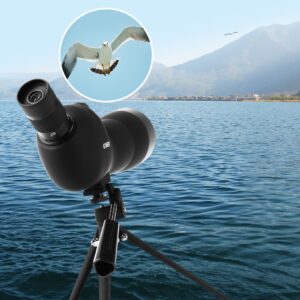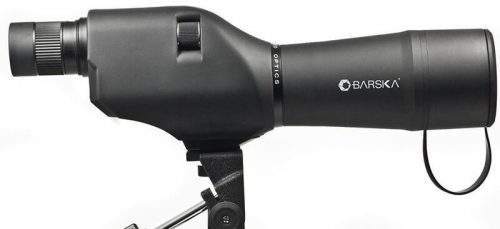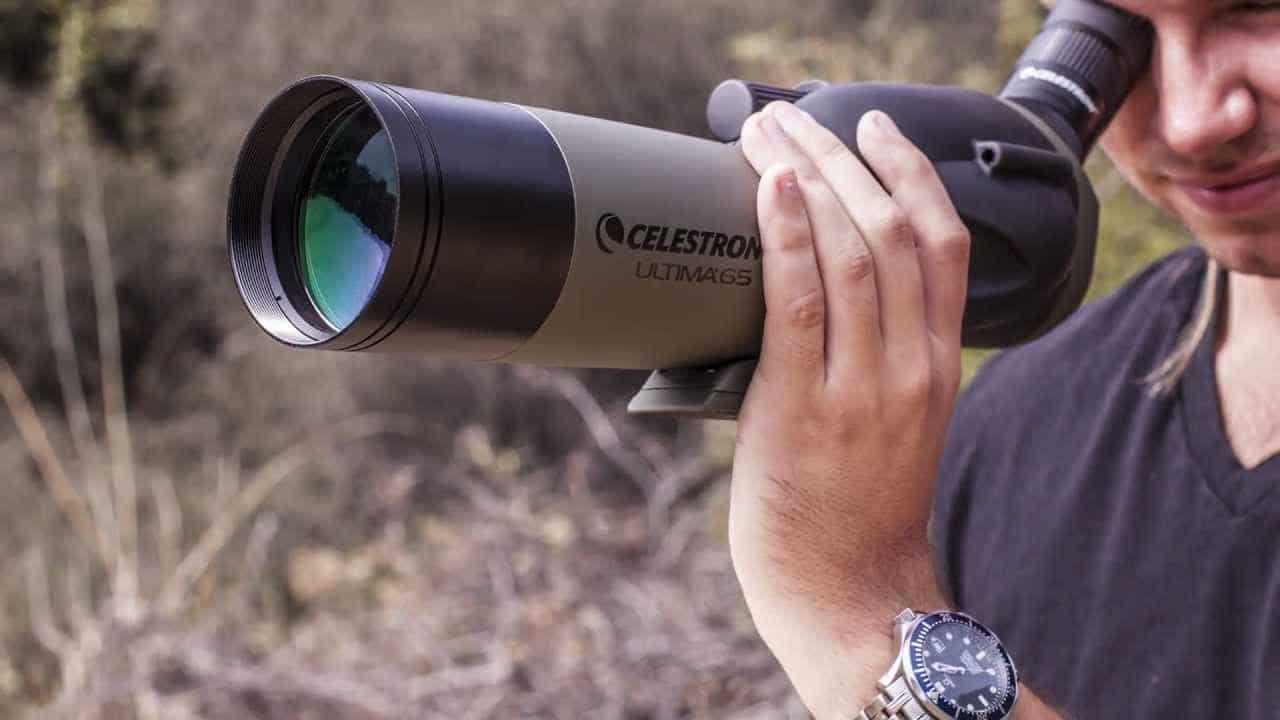Over the years, spotting scopes have been used for all sorts of recreational activities and events. Have you ever noticed that many of these activities such as hunting, general nature observation, or birdwatching require you to locate very specific faraway objects?
In addition to nature observation and other specifics, target shooting and spectator (stadium) viewing also depend upon these requirements. And recently, birders have experienced a surge in snowy owls as a result of the falling mercury. In any case, if you’re serious about your observations, you’re going to need a serious optic, such as a spotting scope.
Spotting scopes deliver larger magnification capabilities than most powerful binoculars. In addition, many spotting scope eyepieces can produce magnifications of up to 60 times or higher. As such, the optical quality of a spotting scope can be the difference between a truly enjoyable outdoor adventure outing versus a tiresome and frustrating experience.
But do not worry — whether you’re delving into extreme long-range shooting or simply want to step up your game for observing birds and wildlife, a spotting scope can truly be a wise investment. As always with any optic purchase, be aware that you should avoid buying the first spotting scope you may find that comes with an attractive price tag.
Table Of Contents
Research, Research, and More Research
Before you spend your hard-earned money on a spotting scope or any other optic for that matter, you need to make sure you carefully research what’s out there — check prices and read online reviews to find out the latest and greatest trends on the market. And lucky for you that you’ve discovered this review where we cover all the fine details of various models of spotting scopes available.
Furthermore, for this review, you’ll not only learn what to look for in a spotting scope, you’ll also discover some of the best spotting scopes for the money. In addition, if your budget is a major concern and you’d rather not spend too much money on your spotting scope, we have quite of few for you to check out.
So, let’s get right to it and offer you some very handy tips for when you decide to shop for that perfect spotting scope for your needs.
How to Choose a Spotting Scope
If you’re like most of us, questions will begin to run through your mind. How do you know what the right scope is for you? How much money should you spend? While some outdoor enthusiasts may narrow it down to their budget, others go straight for the features, such as glass, magnification, or angled body versus straight body.
If you tend to stray from the norm, you may prefer to choose a spotting scope strictly by its weight and size, as well as for its recommended use. If you fall into this category, look no further. With this buying guide — chock-full of information and suggestions, you’ll know exactly how to answer these questions by the time you decide to buy a scope.
If you consider that some of the best spotting scopes in the nation and the world have extuberant price tags, it might be best to narrow down the scope to one that you can afford. While everyone has a different budget to work with or whether you’re limited to spending $100 or less, there is surely a spotting scope that will suit your needs and your budget.
With that being said and with much research on some of the best optics out there, have a look at a complete list of spotting scopes that we here at Gun News Daily consider some of the best in their price category. It’s very true that a large part of the cost of your spotting scope is highly contingent upon the features it has, such as the power of magnification.
Magnification
When it comes to magnification, there are certain aspects to consider such as low power, high power, fixed or zoom lenses. It can be difficult to choose, but it’s wise to pick one that maximizes your power settings.
With magnification, it’s safe to say that not all specifications are created equal. For example, a 20-60×80 may not be as powerful or as far-reaching as one that is smaller. On the other hand, high-powered spotters are very convenient for when you need a precise view of that far away object.
Aperture/Objective Lens Size
As a new spotting scope consumer or a veteran, you should know that the larger the objective lens size, the more light-gathering capability your spotting scope has. But, where to start when it comes to choosing between the most common sizes, such as 50mm, 60/65mm, or up to 80/82mm?
Regardless of how long you’ve been using a spotting scope, you should always begin with accessing the priorities of your hunting style. Then, consider the pure size and weight that a larger objective lens may heap onto the overall spotter. For most hunters and even bird watchers, either a 60mm or an 80mm aperture is the most preferred size.
Best Quality Glass
Magnification power has a great deal to do with the clarity and reach of a spotting scope. The quality of glass actually plays a pivotal role in the glass more so than anything else. High-powered spotters that neglect the quality optics to provide a clear and magnified image are more or less a waste of money.
Eyepieces
When it comes to choosing an eyepiece, consider if an interchangeable eyepiece system is for you. With interchangeable eyepieces, you can change the power range from a zoom setting to a fixed.
Many high-end spotters don’t include the eyepiece in the scope purchase, which means you’ll have to buy it separately — this can become rather costly. If you have the funds, you might want to up your budget if you desire the versatility an interchangeable eyepiece system provides.
Angled vs Straight
Choosing between an angled or a straight body will come first under your list of considerations when you’re ready to invest in a spotting scope. Factors such as, what are the advantages of one style over the other? And, will you need to share your optic with others while in the field?
Choosing a spotting scope doesn’t have to seem like you’re venturing into foreign territory. With a little of the right information from the right reviews, you’ll soon know exactly what you want in a spotter and specifically, how you will use one.
All hunters with different skill levels can easily use a straight spotting scope. But, they’re especially user-friendly and intuitive for new users to spotting scopes because it’s easier and faster to spot and track moving targets.
The rule of thumb is to use a straight spotting scope for hunting and target shooting. Straight scopes will prove especially convenient if you regularly hunt and shoot from tree stands, blinds, or car mounts. In addition, they also work well for nature observing and bird watching.
Angled spotting scopes usually have the eyepiece at a 45-degree angle to the scope body. They are best used for hunting, birding, and casual astronomy use. Angled spotting scopes are quite versatile for all-around, general use.
Whether angled or straight, not fret … with our research and comparisons of different brands of scopes, you’ll find everything you need to know to make the most well-informed decision. We don’t want you to make the mistake of buying a lemon or the very first one you see. Read on for our best spotting scope picks for the money …
Which Brand of Spotting Scopes to Choose?
Many companies are very well known for creating and producing affordable optics for the everyday hunter, birder, or hiker. Yet still, other companies are simply best-in-class when it comes to price tags that are well above the average budget of today’s hunter.
Nevertheless, each of these brands does have something in common — they’re some of the best in the world at manufacturing high-quality, affordable spotting scopes.
Barska
The Barska brand is one of the most reputable names in the tactical and hunting optics industry and they’ve been around for quite some time. With distribution in over 40 countries, Barska delivers optics for the avid hunter as well as the enthusiastic birder.
The Barska name offers a variety of in-stock and fine low-budget prices — plus their name stands behind their workmanship. Let’s take a look at one of their very affordable spotting scopes …
1. Barska 20-60×60 Zoom Colorado Spotting Scopes
The Barska 20-60×60 Zoom sports fully coated optics, which are capable of passing visuals below the 60x zoom limit. And you can use this scope to sight bullet marks up to 300 yards for a wide range of bullet calibers, but this applies only to high-contrast targets.
Offered at a very affordable price, Colorado’s optics are housed in a robust, lightweight body with rubber armoring that can stand against bumps and drops in the field. In addition, it’s fogproof and waterproof, so weather conditions will not get in the way of your sightseeing or birding.
On the other hand, this scope lacks restricted eye relief (13mm maximum), so it may be rather tough for those who wear eyeglasses. The FOV range of 114-50 feet is also pretty generous for the price of this scope.
The budget nature of this scope means there are some complaints about the manufacturing defects. But not to worry — Barska’s limited lifetime warranty policy will have your back should something be defective with your spotting scope.
| Pros | Cons |
|---|---|
| Extremely budget friendly | Somewhat grainy visuals at 60x zoom setting |
| Lightweight construction and durable | Minimal eye relief |
| Limited lifetime warranty |
Barska 20-60×60 Zoom Colorado Spotting Scopes – Features
- Powerful and precise zoom
- 20-60x magnification range
- 60mm objective diameter
- 13-11 mm eye relief
- Lightweight composite body with rubber-armored housing for durability
- Includes a soft carrying case as well as a tabletop pan-head tripod for stable viewing
- Imported
- Check the latest price on Amazon
Celestron Spotting Scopes
| Product Name | Where to Buy | |
|---|---|---|
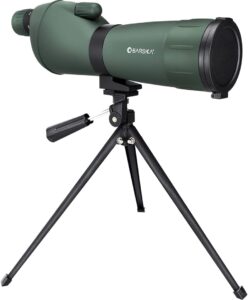 | Barska 20-60x60 Zoom Colorado | |
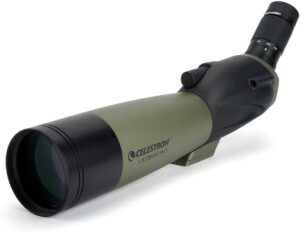 | Celestron 80mm Ultima Zoom | |
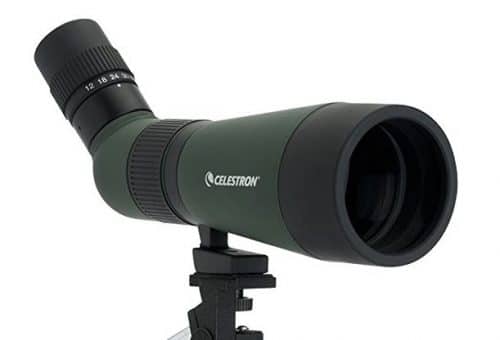 | Celestron Landscout 12-36x60 | |
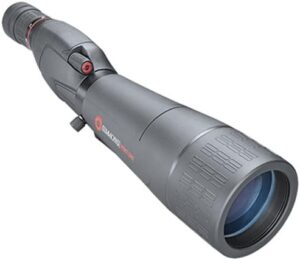 | Simmons Venture 20-60X60 | |
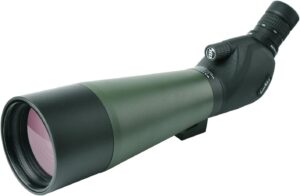 | Gosky 20-60X80 Porro Prism |
Celestron is a telescope optics giant that also caters to hunters and nature enthusiasts. For decades they have been providing entry-level optics and their spotting scopes are a fine example of their reputable work.
2. Celestron 80mm Ultima Zoom Spotting Scope
This spotting scope may not be an exact budget scope because it’s more expensive than other budget models, but the Celestron Ultima 80mm is still one of the best choices on the market. What’s great about this scope is that it can also be used for popular applications.
With a rather significant 80mm objective over the typical 50mm and 60mm options available at lower prices, the Celestron 80mm manages to provide an honorable image even at the highest zoom.
The Celestron 80mm Ultima also features waterproof controls which allow you to use it in less than favorable weather conditions, although there is a bit of a tight eye relief. Lucky for you, the limited lifetime warranty from Celestron will ensure a replacement if you end up with a product you are not happy with — but this usually doesn’t happen.
| Pros | Cons |
|---|---|
| Great for casual astronomical observation | Limited eye relief |
| Strong, waterproof construction | Chromatic aberration |
| Limited lifetime warranty |
Celestron 80mm Ultima Zoom Spotting Scopes – Features
- 80mm refractor spotting scope
- Multi-coated optics
- 45-degree viewing angle
- 20-60x zoom eyepiece
- Waterproof
- Includes soft carrying case
- Limited lifetime warranty
- Amazon’s choice!
3. Celestron Landscout 12-36×60 Spotting Scopes
The Celestron Landscout is another low-cost, lightweight spotting scope designed to be an easily portable optic for people who don’t want to be bothered with taking care of an expensive spotting scope. Boasting a generous 60mm objective diameter plus multi-coated optics, this scope is able to yield bright images suitable for most bullet mark sightings up to 300 yards.
On the other hand, optical limitations with this scope are apparent due to its low 36x magnification cap. In addition, you won’t be able to use it for mainstream spotter applications such as astronomy, long-range hunting, or observing birds.
The construction of the Landscout is quite decent for a budget-friendly optic. With a non-slip rubber focus ring to make it simple to zero in on your subjects, this scope also features an integrated tripod mounting collar which can be rotated to modify the viewing angle to suit your needs.
The Celestron Landscout also sports a low zoom limit, which means a decent FOV (field of view) range. However, the restrictive 18-14mm eye relief may create problems for those who wear eyeglasses.
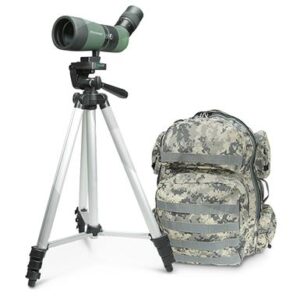
In addition, there are some consumers who have complained of less than desirable focusing and abnormal blurriness as well. But, considering the price of this product, it’s really not an issue if you know this ahead of time.
Just like its sibling, the Ultima, the Landscout comes with a limited lifetime warranty. And to be clear, this scope performs with an extremely reliable core performance and is truly a great value at a price of just under $100.
| Pros | Cons |
|---|---|
| Inexpensive | Restrictive eye relief |
| Lightweight, compact design | Not for long-range spotting scope applications |
| Easy focusing | |
| Adjustable tripod collar |
Celestron Landscout 12-36×60 Spotting Scopes – Features
- Fully coated optics
- Compact, lightweight design
- 12-36x magnification range
- 60mm objective diameter
- 18-14mm eye relief
- Rotating tripod mount
- Large focus wheel with rubber grip
- Limited lifetime warranty
4. Simmons Venture 20-60X60 Spotting Scopes
Simmons is a preferred brand when you really want an affordable, practical, and intuitive optic. If you’re low on funds, do you seriously want to compromise on optical size and performance? If you’re not and somewhere in between, don’t worry, Simmons is the brand that can get the job done — all at an affordable price.
You can trust Simmons. Why? Simply because they offer low-budget optics, and partnered with a fine reputation on a higher level than other brands. The Simmons ProSport 20-60×60 spotting scope has BK7 glass prisms, fully coated optics, and super magnification ranging from 20-60 times. It’s also completely weatherproof and fully wrapped in rubber armoring.
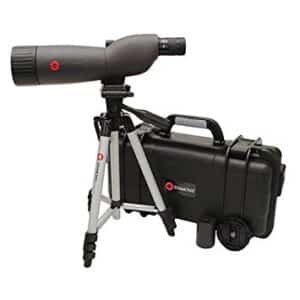
This model currently has a solid base of thumbs-up reviews online, while it boasts an above-average rating. For a spotting scope under $100, this rating is well-deserved and is the reason we gave it a top choice on this list of best spotters in this affordable price range.
Simmons may not be considered a top-of-the-list brand, but they’ve been making hunters and birders happy for many decades. If you’re looking for an optic that checks all the boxes without being overly priced, Simmons Optic should be one of your first choices.
| Pros | Cons |
|---|---|
| Affordable price | Not digiscope adaptable |
| Elevated power | Tripod quality could use improvement |
| User-friendly | |
| Durable and fully weatherproof | |
| Compact design and lightweight |
Simmons Venture 20-60X60 Spotting Scopes – Features
- Quality optics with stunning HD clarity
- 100% quality materials tested extensively
- Handsome design with durability built to last
- 20 to 60x magnification and 60mm objective lens spotting scope
- High-quality BK7 prisms with fully coated optics for bright, sharp images
- Rugged non-slip rubber armor absorbs shock and provides a firm grip if wet
- 100 percent waterproof and fog-proof with a built-in sunshade for glare reduction
- Comes fully included with a tripod, soft carrying case, and premium hard-shell plastic case
- Check the latest price on Amazon
5. Gosky 20-60X80 Porro Prism Spotting Scopes
Fully multi-coated optics and an 80mm objective lens deliver excellent light transmission even when it gets a bit dark, with the Gosky Porro Prism Spotting Scope. And speaking of precise light transmission, users have reported being able to sight in and take photos of lucid shots of the moon with this scope at 60x zoom.
For the everyday user, it means that this scope is a completely reliable budget scope that can be used for hunting, bird watching, photography, and even amateur astronomy. The body of the Gosky 20-60×80 Porro Prism Spotting Scope is made from durable, corrosion-resistant alloy and is covered by rubber armor. It can be used in tough outdoor conditions, especially since it’s also fully sealed to make it waterproof.
A great perk about this scope is that it comes with a digiscoping cell phone adapter that can be used by outdoor enthusiasts to create impromptu videos of wildlife and target practice or simply roam along the trails.
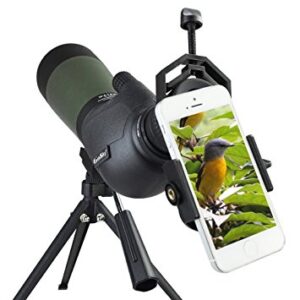
Typically, the feedback from users has been positive, with only a few complaints regarding less than par-visual performance — most likely from consumers complaining about poor visual performance. In addition, the Gosky manufacturer always stands behind their products and offers no charge for defective units. The Porro Prism is an all-around solid choice.
| Pros | Cons |
|---|---|
| Great price | Limited eye relief |
| Clear and bright long-range visual output | |
| Substantial field of view | |
| Durable and waterproof construction | |
| Excellent customer support |
Gosky 20-60X80 Porro Prism Spotting Scopes – Features
- Fully multi-coated 80mm objective lens
- Eyepiece and quality prism included
- Delivers clear, crisp images
- 20x to 60x magnification range
- Dynamic lens focusing system for easy zoom-in on target
- Designed for birdwatching, wildlife observation, and scenery
- Shock-absorbing rubber armor makes for maximum protection
- Waterproof design
- Equipped with a digiscoping adapter for digiscoping and carrying case
- Equipped with stretchable eyepiece and lens protection covers
- Includes cleaning cloth and straps
- Check the latest price on Amazon
Best Spotting Scopes for the Money – Final Thoughts
While the market offers a number of budget spotting scopes, especially for beginners, it is best that you understand your overall needs and preferences beforehand. As you have read in this article, we have reviewed some of the best spotting scopes for the money.
Most people assume that spotting scopes are expensive. While this is true of most spotting scopes, you will be glad to know that you can get a great spotting scope for the money without compromising on quality.
Before you invest in a spotting scope, your best bet is to ask yourself a list of questions and concerns. For example, if you take into account a spotter’s performance in various weather conditions, coupled with the price of the spotting scope, you will be able to get the exact features you desire in an affordable spotting scope.
While all of these spotting scopes are terrific for the price, if we had to choose, our favorite would be the Gosky 20-60X 80 Porro Prism Spotting Scope. It’s a very well-rounded optic and at the same time, extremely tough and durable … therefore it’s our top choice for the best spotting scope for the money.
If the Gosky model isn’t for you, do not worry — each of the reviewed spotting scopes is a very good pick for your money. In addition, it really comes down to how much you are willing to spend.
Nevertheless, every one of the spotting scopes we have reviewed is constructed of exceptional quality, durability, and extremely affordable pricing. The choice is yours!
Recommended Reading
Vortex Diamondback Spotting Scope


